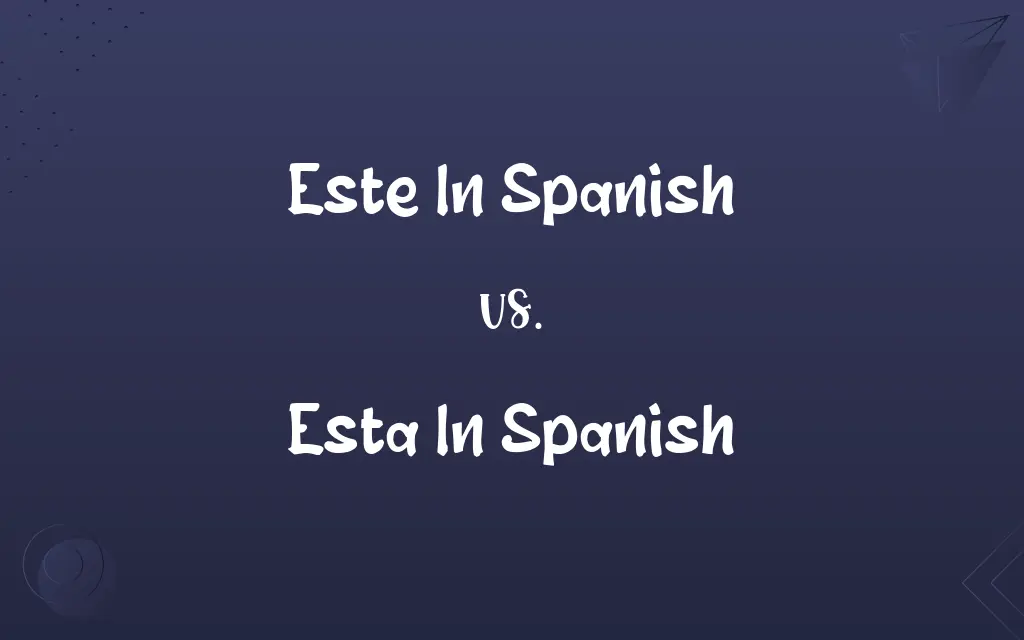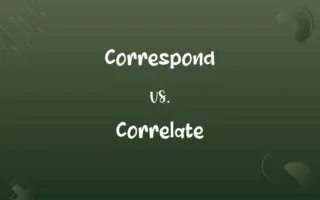Este In Spanish vs. Esta In Spanish: Know the Difference

By Shumaila Saeed || Published on February 29, 2024
Este (masculine) and Esta (feminine) are Spanish demonstrative adjectives meaning "this." "Este" is used with masculine nouns, while "Esta" is for feminine nouns.

Key Differences
Este in Spanish is a demonstrative adjective used to indicate a specific object or person close to the speaker and is used with masculine singular nouns, like "este libro" (this book). Esta, on the other hand, is also a demonstrative adjective, but it aligns with feminine singular nouns, such as "esta casa" (this house), highlighting the gender distinction in Spanish nouns.
Shumaila Saeed
Feb 29, 2024
In terms of usage, Este is applied to refer to a time, object, or situation close in time or physically near. For example, "Este momento es importante" (This moment is important). In contrast, Esta is used similarly but agrees with feminine entities: "Esta idea es genial" (This idea is great), underlining the gender agreement in Spanish grammar.
Shumaila Saeed
Feb 29, 2024
Este can also function as a pronoun, replacing a noun, and is used for masculine subjects, like "Este es mi amigo" (This is my friend). Esta follows the same rule for feminine subjects, for instance, "Esta es mi hermana" (This is my sister), demonstrating their role as both adjectives and pronouns.
Shumaila Saeed
Feb 29, 2024
Este and Esta differ phonetically but share a common function in denoting proximity. While Este carries a masculine connotation, as in "Este hombre" (This man), Esta distinctly refers to feminine subjects or objects, like in "Esta mujer" (This woman), emphasizing the gendered aspect of Spanish language.
Shumaila Saeed
Feb 29, 2024
Lastly, understanding the context is crucial. Este might be used to introduce something, such as "Este es el camino" (This is the way), while Esta can introduce a feminine subject or object, like "Esta es la respuesta" (This is the answer), indicating their versatile but gender-specific usage.
Shumaila Saeed
Feb 29, 2024
ADVERTISEMENT
Comparison Chart
Gender Agreement
Used with masculine nouns (e.g., este hombre)
Used with feminine nouns (e.g., esta mujer)
Shumaila Saeed
Feb 29, 2024
Function as Pronoun
Can replace masculine nouns (e.g., Este es Juan)
Can replace feminine nouns (e.g., Esta es Ana)
Shumaila Saeed
Feb 29, 2024
Indicating Proximity
Refers to objects or situations close to the speaker (e.g., este libro aquí)
Refers to objects or situations close to the speaker (e.g., esta casa aquí)
Shumaila Saeed
Feb 29, 2024
Phonetic Distinction
Pronounced with a masculine tone (e.g., este coche)
Pronounced with a feminine tone (e.g., esta calle)
Shumaila Saeed
Feb 29, 2024
Usage in Sentences
Used in sentences with masculine subjects or objects (e.g., Este día es especial)
Used in sentences with feminine subjects or objects (e.g., Esta noche es tranquila)
Shumaila Saeed
Feb 29, 2024
ADVERTISEMENT
Este In Spanish and Esta In Spanish Definitions
Este In Spanish
Introduction (Masculine)
Este señor necesita ayuda. (This man needs help.)
Shumaila Saeed
Jan 13, 2024
Esta In Spanish
Proximity Indicator (Feminine)
Esta llave abre la puerta. (This key opens the door.)
Shumaila Saeed
Jan 13, 2024
Este In Spanish
Time Reference (Masculine)
Este momento es importante. (This moment is important.)
Shumaila Saeed
Jan 13, 2024
Esta In Spanish
Demonstrative Adjective (Feminine, Singular)
Esta casa es bonita. (This house is beautiful.)
Shumaila Saeed
Jan 13, 2024
Este In Spanish
Pronoun Replacement (Masculine)
Este es mi amigo. (This is my friend.)
Shumaila Saeed
Jan 13, 2024
ADVERTISEMENT
Esta In Spanish
Pronoun Replacement (Feminine)
Esta es mi hermana. (This is my sister.)
Shumaila Saeed
Jan 13, 2024
Este In Spanish
Demonstrative Adjective (Masculine, Singular)
Este coche es rápido. (This car is fast.)
Shumaila Saeed
Jan 13, 2024
Esta In Spanish
Time Reference (Feminine)
Esta mañana fue fría. (This morning was cold.)
Shumaila Saeed
Jan 13, 2024
Este In Spanish
Proximity Indicator (Masculine)
Este libro está aquí. (This book is here.)
Shumaila Saeed
Jan 13, 2024
Esta In Spanish
Introduction (Feminine)
Esta mujer trabaja aquí. (This woman works here.)
Shumaila Saeed
Jan 13, 2024
Repeatedly Asked Queries
Is "este" only used for objects near the speaker?
Yes, "este" indicates something close to the speaker.
Shumaila Saeed
Feb 29, 2024
How is "este" used in a sentence?
"Este" is used as an adjective or pronoun for masculine nouns, like "este coche" (this car).
Shumaila Saeed
Feb 29, 2024
What's the difference in pronunciation between "este" and "esta"?
The pronunciation differs slightly, with "este" having a masculine tone and "esta" a feminine tone.
Shumaila Saeed
Feb 29, 2024
Is "este" used for singular or plural nouns?
"Este" is used with singular masculine nouns.
Shumaila Saeed
Feb 29, 2024
Can "esta" be used with any noun?
"Esta" is specifically used with feminine nouns.
Shumaila Saeed
Feb 29, 2024
Can "esta" be used to introduce someone?
Yes, "esta" can introduce a feminine subject, like "Esta es mi amiga" (This is my friend).
Shumaila Saeed
Feb 29, 2024
Can "esta" replace a noun in a sentence?
Yes, "esta" can function as a pronoun, replacing a feminine noun.
Shumaila Saeed
Feb 29, 2024
What gender is associated with "este"?
"Este" is associated with masculine nouns.
Shumaila Saeed
Feb 29, 2024
Can "esta" indicate proximity?
Yes, "esta" indicates that something feminine is physically close.
Shumaila Saeed
Feb 29, 2024
Does "este" have a plural form?
Yes, the plural form is "estos" for masculine nouns.
Shumaila Saeed
Feb 29, 2024
Is "este" appropriate for indicating time?
Yes, "este" can refer to a moment in time, like "este momento" (this moment).
Shumaila Saeed
Feb 29, 2024
Is "este" used in formal or informal contexts?
"Este" can be used in both formal and informal contexts.
Shumaila Saeed
Feb 29, 2024
Is there a neutral form of "este" or "esta" in Spanish?
No, Spanish demonstratives agree in gender with the nouns they describe.
Shumaila Saeed
Feb 29, 2024
Is it mandatory to use "esta" with feminine nouns?
Yes, for correct grammatical agreement.
Shumaila Saeed
Feb 29, 2024
Can "este" and "esta" be used interchangeably?
No, they are used based on the gender of the noun they describe.
Shumaila Saeed
Feb 29, 2024
Are "este" and "esta" used in written and spoken Spanish alike?
Yes, they are commonly used in both forms of communication.
Shumaila Saeed
Feb 29, 2024
What is the plural form of "esta"?
The plural form is "estas" for feminine nouns.
Shumaila Saeed
Feb 29, 2024
Are "este" and "esta" used differently in different Spanish-speaking countries?
The basic usage remains the same, though colloquial applications may vary.
Shumaila Saeed
Feb 29, 2024
Can "esta" be used for abstract concepts?
Yes, if the concept is feminine, like "esta idea" (this idea).
Shumaila Saeed
Feb 29, 2024
Can "este" be used without a noun?
Yes, "este" can stand alone as a pronoun, like in "Este es el que quiero" (This is the one I want).
Shumaila Saeed
Feb 29, 2024
Share this page
Link for your blog / website
HTML
Link to share via messenger
About Author
Written by
Shumaila SaeedShumaila Saeed, an expert content creator with 6 years of experience, specializes in distilling complex topics into easily digestible comparisons, shining a light on the nuances that both inform and educate readers with clarity and accuracy.






































































